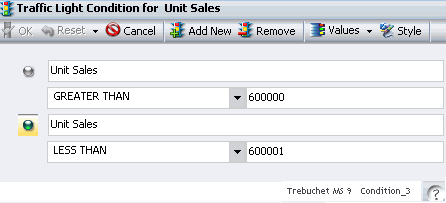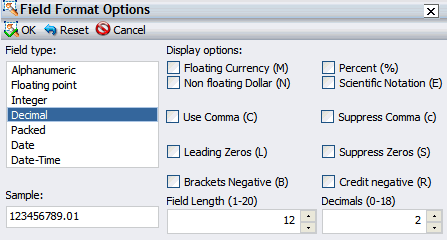Customization options
When creating a report in Report Creator, you can perform the following style customizations.
Report level style
Apply styles "globally" for an entire report or compound document by using the Style button in the Report group of the Home tab. It is also available in the Query Design, Interactive Design, and Document views.
Selecting Style opens a dialog for applying global styles to the entire report. Choose from these options:
- font family
- font size
- font color
- background color
- text justification (left, center, right)
- font style (bold, italic, underline)
- reset styles from the template
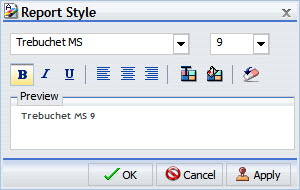
Tip: Reset only works while the Report Style dialog is open. When you click OK, all changes are committed.
To undo global styles after it has been committed, use the Undo command from the Quick Access Toolbar.
Data and column titles
- To customize data, column titles, or both, select the data source in the query design pane
- Then on the Field tab, Style group select an option.
Alternating rows colors
Customize rows of data with alternating colors in the report output for the selected data source field.
- From the Home tab, Report group, select Banded.
- A color selection dialog provides an alternating color scheme.
- Before you save, make sure that the selected color displays in the Selected Color field and that the Transparent check box is NOT selected.
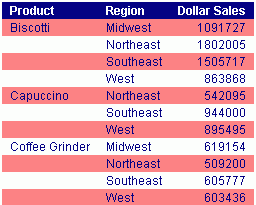
The report output displays alternating rows of data, using a white background for one row and a background of the selected color for the next row.
Cell padding
Customize the amount of space between rows and columns from the Layout Tab, Report group, select Custom.
The Cell Padding dialog allows you to modify left, bottom, and right spacing.
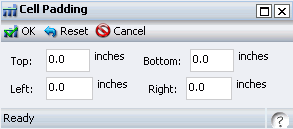
Headers and footers
Make a report more meaningful by adding headers and footers. They supply context and key information about a report, its purpose, and audience. Headers and footers also provide structure for navigation and visual appeal.
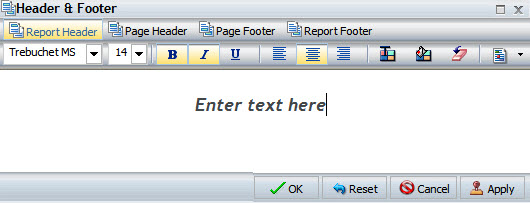
Note: This feature is available in Query Design view, Interactive Design view, and Document view.
This feature is available in Query Design, Interactive Design, and Document views.
- On the Home tab, Report Group, click Header and Footer to open its dialog.
- The selected header or footer is now active.
- Add or style the active header or footer, or choose a different one to work with by selecting the applicable tab.
- If you switch tabs, Report Creator does not save changes made on the tabs until you click Apply or OK.
If you click Apply, the dialog remains open.
If you click OK, the dialog closes.
- If you switch tabs, Report Creator does not save changes made on the tabs until you click Apply or OK.
- Style a selected header or footer using common font style options.
- Insert quick text into a header or footer.
- Quick text is supplied for you. It includes information that is typically useful in identifying a report or chart.
- Preformatted text drop-down options:
Preformatted text options
- Draft
- Page X of Y
- Confidential
- When a header or footer is added, double-click it on the canvas in design mode to reopen the Header and Footer dialog. You can also right-click an existing header or footer in design mode and select Edit from the menu to open the dialog.
Font customization options
Traffic Light conditional styles
You can apply conditional traffic light styles to data for a selected numeric measure field. By default, the report displays values that satisfy the first condition in green, and values that satisfy the second condition in red.
- Select a field, then in the Field tab, Specific group select Traffic Lights.
- The Traffic Light Condition dialog opens, displaying green light selection fields.
- Select and type green light criteria in these fields.
- It contains criteria to display values for Unit Sales that are greater than 600000 in green, and values for Unit Sales that are less than 600001 in red.
- From the drop-down menu below the selected data source field name, choose one of its relational operators:
- Equal to
- Not equal to
- Greater than
- Less than
- Greater than or equal to
- Less than or equal to
- In the field to the right of the operator drop-down menu, type the desired value for the selected operator. Data values that meet criteria will display in green in the report output.
Instead of typing a value, you can select an option from the Values drop-down menu, and choose a data value from the dialog.
- Values drop-down menu options
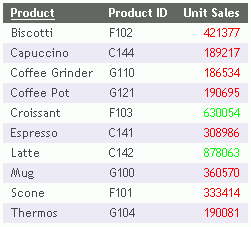
- Click Add New to add another red light condition.
The red light selection fields are displayed in the Traffic Light Condition dialog, where you can select and type red light criteria in the same manner.
Additional options
- Delete an existing traffic light condition - click the Remove button.
- Change colors or styles - click the Style button.
- In the Style pop-up menu that opens, click the color
 icon to open the Color dialog and choose new colors for additional traffic light conditions.
icon to open the Color dialog and choose new colors for additional traffic light conditions.
- In the Style pop-up menu that opens, click the color
- Add more traffic light conditions - click Add New and select a different color for each new condition that you specify.
The data in the Unit Sales column is displayed in either green or red, according to the criteria that was specified in the Traffic Light Condition dialog.
Field format
You can change the default formats that are assigned to a virtual or column field.
- From the Field tab, Format group, drop-down menu, select from the most common field type options (Alphanumeric, Integer, or Decimal), or use buttons under the drop-down menu to apply alternative options (floating or non-floating currency and percent signs, commas, or increase or decrease decimal places).
- If you select More Options on the drop-down menu, or right-click the field and select Edit Format, the Field Format dialog opens.
Field format options
| Task | Parameter | Description |
|---|---|---|
| Assign alphanumeric format | Field Type | Select Alphanumeric |
| Change alphanumeric format length | Field Length | Enter a number between 1 and 4095. The default is 20. |
| Assign numeric format | Field Type |
Select one of the following:
If the selected field matches the selected format type, its current length displays in the Length box. Otherwise, the default length displays in the Length box. The Decimal box shows the numbers of decimal places for Floating Point, Decimal, and Packed. |
| Change numeric format length | Field Length |
Enter numbers for format types:
|
| Change number of decimal places for Floating Point, Decimal, or Packed | Decimal | Enter a number |
| Assign date format | Field Type | Select the Date option. |
| Change date display format | Display Options | Select a date format. The default date display format is MDY. |
| Assign date-time format | Field Type | in the select the Date-Time option. |
| Change date-time format | first select the date format to use from either the Year First, Month First, or Day First drop-down menu. Select a time format (if applicable) from the options box on the right. Selecting the Time Only check box lets you set only a time format. |
